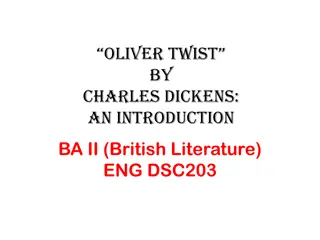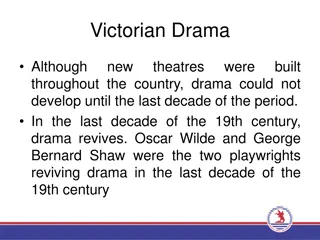Charles Dickens: A Pioneer of Victorian Literature
Charles Dickens, born in 1812 in England, overcame a challenging childhood to become a renowned writer known for vividly capturing the social issues of his time. His novels highlighted the harsh realities of poverty and inequality in Victorian society, using humor and unforgettable characters to depict the struggles of everyday life. Dickens' innovative use of serialized novels made his work accessible to all social classes, cementing his legacy as a literary giant.
Download Presentation

Please find below an Image/Link to download the presentation.
The content on the website is provided AS IS for your information and personal use only. It may not be sold, licensed, or shared on other websites without obtaining consent from the author. Download presentation by click this link. If you encounter any issues during the download, it is possible that the publisher has removed the file from their server.
E N D
Presentation Transcript
Life Charles Dickens was born near Portsmouth- in the south of England- in 1812 but when he was young he moved to London. There, at the age of 12, he was sent to work 12 hours a day in a factory. His father was imprisoned for debt His education up to that moment was scarce, but the factory owner, who was his father s friend, gave him free lessons. Dickens obtained a formal education and in 1827 he started to work, first as a parliamentary reporter and then as journalist. The success of his first works led him to write novels, that he wrote until his death. He suffered a stroke in 1870 and died.
Dickenss novels (1) Dickens s poverty during his childhood influenced his works and his writing. In fact, he had a strong sensitivity for the environment and for the people who lived there. He described the streets and the slums of London in detail. He created unforgettable characters and situations that exposed the inhumanities and the terrible conditions of the Victorian age. However, he only criticised society but didn t propose any revolutionary changes. In general, in his works good overcomes evil.
Dickenss novels (2) His novels were full of sentimentality and melodrama. However, their most important humour, their brilliant dialogues, the vast range of characters. However, his characters are caricatures and focus on some features: avidity (for ex. Scrooge in A Christmas carol), pride (Mr. Bounderby in Hard Times), evil (Bill Sikes in Oliver Twist) or good. Consequenlty, they are flat characters, either all good or all bad. features are: their
Novels in instalments Dickens became very popular because he exploited the system of novels in instalments. Families could buy an instalment (a Chapter) of the book each week. They read it together in the evenings, discussed it and imagined the next week s instalment, similarly to soap operas today. This was also a means propaganda, because it arrived to all social classes. of social and political
Oliver Twist (1837-9) Oliver Twist is the first English novel focusing on a child. It is set in the backstreets and slums of London and describes the terrible conditions of workhouses, the exploitation of children and criminality. Its major elements are: poverty, hunger, murder and blackmail, but they are alternated with moments of comic relief.
Oliver Twist: The plot Oliver Twist is a foundling. He lives in an orphanage until the age of 9. Then he is sent into a workhouse to work for his food. One day, he shocks everybody by asking for more food. As a consequence, he is sold for 5 pounds to work as an apprentice for an undertaker. He decides to run away to London. In London, he makes friends with the Artful Dodger, a pick-pocket, who takes him to his home, Fagin s den. Fagin is the head of a homeless gang and trains boys to steal for him. He is helped by the brutal burglar Bill Sikes and his girlfriend, the prostitute Nancy.
The plot, part II Oliver is forced to work for Fagin as a thief and one night, he is shot while trying to steal from a rich family. The lady of the house, Mrs. Maylie, sees that he s just a boy and decides to take care of him. Nancy visits Mrs. Maylie to help Oliver. With the help of Mr. Brownlow, who had become Oliver s friend, they find out Oliver s true identity and he is adopted by Brownlow. Nancy is killed by Bill Sikes for helping Oliver, but he also dies, while Fagin is captured by the police and hanged. Oliver is saved and the villains are punished.






















